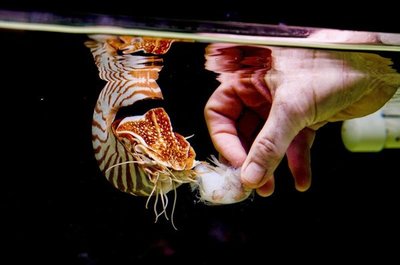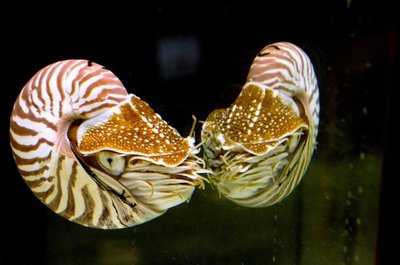February 5, 2009
New residents of Kincaid Hall are in the shell-making business
Foreign visitors are nothing new for the UW campus, but during this school year three strange guests from a distant land have taken up residence in Kincaid Hall.
They are chambered nautiluses — tropical cephalopods with exotic-looking shells — and they are living in a large tank of water in the laboratory of Biology Professor Peter Ward.
Cephalopods are characterized by having two symmetrical halves of the body and tentacles. Those without shells, cousins to the nautilus, include the squid and octopus.
Ward is examining the nautiluses’ kidneys, specifically the function of kidney stones that possibly are a calcium reserve used to make new shell.
As a nautilus grows, it develops new chambers in its shell and the body moves progressively from chamber to chamber. As it moves to a new chamber, it creates a wall of shell material to mostly close off the old chamber, and eventually — once the shell is thick enough to withstand the pressure — water is pumped out of the old chamber.
Ward has used x-rays to observe various stages of the kidney stone process. He hopes to discover how nautiluses use their kidney stones. If he can discover the key, and if the process can be adapted in some way to humans, he sees the potential to deal with issues such as tooth decay and osteoporosis.
Nautiluses normally live about 1,000 feet deep, often around coral reefs, where there are far fewer predators than in shallow water. However, at that depth they must develop shells that can withstand 30 times more pressure than is present at the surface.
“It’s a hard life at that depth and they grow very slowly,” Ward said.
The UW visitors — simply named A, B and C — mostly feed on shrimp, and can move quickly within the tank. But because they are now living at sea level, they are developing substantially thinner shells, Ward said.
These nautiluses are about 5 inches across and are nearly full sized, he said. But Ward noted that millions of years ago, when the creatures were found all over the world, some reached a size of 15 feet across. In fact, Ward used his visitors to reconstruct models of the 15-foot creatures for a new documentary series called Animal Armageddon, which will debut next month on cable TV’s Animal Planet.


